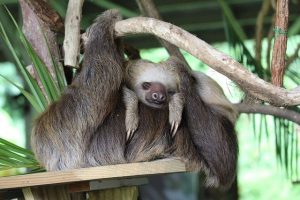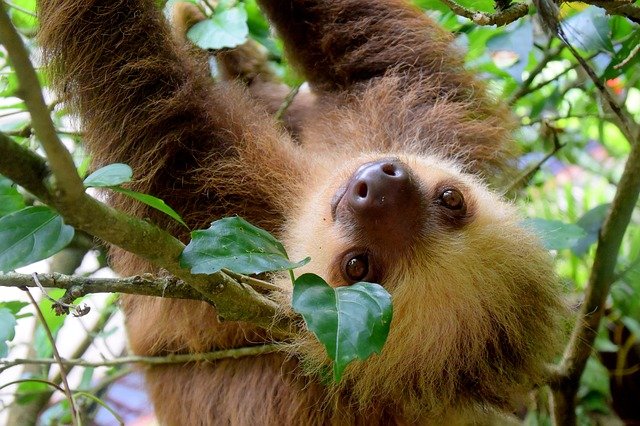The first time I saw a sloth, I was astonished at how slow the creature could be, and how unbothered it was about what happened around it and how other species of animals could do a whole lot of things first before the Sloth accomplishes the first task it is set to accomplish.
In fact, the first time I saw it, it spent the whole day writing a mail. It spent the day writing because the first time I saw it was in an animation and I was marveled at how a living organism could live in the world of other organisms and still not be bothered about time. The sloth exhibits an attitude that shows that it probably leaves in a world own in its mind.
In this article, we will be sharing with you some of our findings on why the species of sloths are slow. Enjoy your read through the succeeding paragraphs.
Description of the Sloth
The sloth is however a specie of the arboreal mammal, and is mostly known for its very slow pace during its active moments, it is also known for spending more than half of each day sleeping, in an abnormal sleep position (it sleeps on the tree while hanging upside down). The Animal sloths exist in different sizes, and in different weights, depending on its species, as well as its stage in its life cycle.
Now, the adult species of the sloth usually can be quite long, like as long as about twenty-four to thirty-one inches, with a weight of between seven point nine pounds and seventeen pounds (7.9-17 pounds). More so, the two-toed species of the sloth appears to be a little bigger than three-toed species of sloths. The species of sloths often have limbs that seem to be quite longer, and heads that are quite big in size with a perfect natural blend of ears that equally appear to be quite tiny.
Again, the species of sloths have tails that are usually about two point four inches long (2.4 inches long). Even though the species of sloths are a type of mammals, the different species of sloths are very different mammals especially following the fact that they do not have any seven cervical vertebrae.
While the three-toed species of sloth has about eight to nine cervical vertebrae, the two-toed species of sloth has about five to seven cervical vertebrae. In addition to other features of the species of sloth, the different species of the sloths have quit poor hearing ability as well as the visual acuity. As a result of the poor hearing ability of the different species of sloths, the different species of sloths however predominantly depend almost totally on the species’ sense of touch, and sense of smell in the hunt or quest for food.
More so, the different species of sloths have their hair or furs grow away from extremities which is probably because they place their limbs above their body(s). Their appearance seems to be like a shaggy coat, that usually becomes a habitat for some other parasites like the Algae and the arthropods.
The description of the animal sloth will not be complete if the different kinds of the species of the sloth are not duly outlined. So the next paragraph in this section will briefly share the different kinds of the species of sloths.
The sloth has about six different species, that belong to two different broad species of families of the sloth. The two different broad species or families of the sloth under which the other species or kinds of sloth belong to or find their classifications include the following: the two-toed species of sloth, and the three-toed species of sloths.
However, it is necessary to understand that all species of sloths each have three toes on each of its rear limbs, now the difference between the two-toed species or family of the sloth is that the two-toed species do not have any front limbs, while the three-toed species or family of the sloth has front limbs.

More so, the different species of the sloths are predominantly found in the area of the tropical rainforest of Central America, and South America. This species of arboreal mammal is called or were named “SLOTH” largely as a result of the very slow rate of the arboreal mammal’s metabolism, as well as the intentional act of the sloth to give itself to slow movement.
Furthermore, the arboreal mammal sloths really move on a very fast pace when in water than its regular pace when on land, where the arboreal mammal seem to be totally helpless.
Species of sloths
The Species of Sloths as divided into the two-toed and three-toed include the following:
- Linnaeus’s two-toed sloth (Choloepus didactylus)
- Hoffman’s two-toed sloth (Choloepus hoffmanni)
- Pygmy three-toed sloth (Bradypus pygmaeus)
- Maned sloth (Bradypus torquatus)
- Pale-throated sloth (Bradypus tridactylus)
- Brown-throated sloth (Bradypus variegatus)
Why Are Sloths Slow?
This is the major issue of this article, an inquiry into the reason behind the slow movement of the sloth.
It is common knowledge already that the Sloth is a slow animal, and basically the slowest arboreal mammal on earth; as a matter of fact, it is the slowest animal on earth. In all their activities, they intentionally take their time to do anything they want to do. For instance, when they blink, when they walk, when they climb the trees, it is all done in a very slow motion, so slow that none of the different species of sloth has the ability to really walk over a football pitch in one day; like the arboreal mammal sloth does not see any need to want to hurry over these activities.
More so, the species of sloth are known to mostly spend a huge chunk of their time when they are awake climbing trees. The only time the species of sloths have been recorded to have to leave the ground is on the times they need to defecate, or when they want to go into the water.
A close observation of the movement of different species of sloths have shown that in a day different species of sloths can walk the average of forty yards. A few reasons have been attributed to be behind the very slow movement of the different species of the arboreal mammal (the sloth).
Some of these reasons will be briefly discussed in this section.
Here is a list of why the species of sloth can be slow:
- Evolution
- Diet
- Low Metabolism
1. Evolution
One of the reasons that has been proved to have accounted for the slow movement in the pace of different species of sloths according to Animal scientists, is basically the evolution of the different species of the arboreal mammal called sloths. Not only is it the case that the evolution of the animal is tagged responsible for the pace, it is also said that how the different species of sloths survive, also contribute to that.
At this juncture, it is important to categorically state that the present-day different species of sloth are a series of smaller version of the different species of sloths that existed in the primitive world, or best put in the world before history. Archeological as well as forensic investigations have shown that the species of sloths that existed in the prehistoric periods, or in the ancient era were very huge, as matter of archeological facts were giants, and out rightly weighed about several tons.
Given the heights of the ancient species of the sloth, they could be standing on their hind on ground and reach the trees, and the forage from trees without any difficulty or locomotive efforts. The fate of the different species of sloths changed after the evolution years, because the different species of sloths became much smaller in size, hence lacked the ability to reach the forage from the trees on their limbs to talk of while standing on the hind of their limbs. So, they climb up the trees, which is proof of a change in their system.
2. Diet of the Sloth
The time taken to climb the tree as well as the diet of the sloth which is totally based on their intake of leaves have also been a major contributor to the very slow movement of the different species of sloths. This is because, leaves are not very nutritious to be the major diet of any organism, not talk of being the only diet. Also, the consumed leaves do not generate calories on time, neither do they develop enough calories.
So, in order for the species of sloths to reserve energy, the species of sloths unanimously agree to move slowly. In addition to having to work and move at a very slow pace to reserve energy, they also sleep away the most part of the day from their daily fifteen hours sleep, after which they take the rest of the nine hours lumbering all over the trees. More so, given that the environment is already warm, the different species of sloths have no reason to spend a lot of energy trying to keep their body systems warm, so again the reserve some energy by the virtue of dwelling in the tropical rainforest.
3. Low Metabolism
When we look at the factor of evolution, and the factor of diet that has been treated above, the species of sloths have also been proven to have a very slow rate of metabolism or a low metabolism to aid the species of sloths or the arboreal mammal cope with the very little calories derived from the leaves they feed on. The different species of the present day sloths really have very extreme low rate of metabolism, which implies that the different species of sloths without any intention of changing their reputation of being slow move at a very languid, and an extreme sluggish pace around the trees.
It is also important to explain what a low metabolic rate or a low metabolism means. Low metabolism means that the different species of sloths have the ability to survive on very little food.
Conclusion
Sloths are so famously slow that the word “sloth” has actually become synonymous with laziness, lethargy, and a general lack of energy.
Some Amazing Facts of the Sloth
There are a few facts you should know about the sloths and they include the following:
- Proper Parent and Baby Bonding
The different species of female sloths on conception, give birth to only one baby at a time in a year, after the sloths’ gestation period of about six months. The baby species of sloth however sticks around with its mother for a period of time, usually about six months. Within the given period of six months, the sloth spends it grasping the belly of its mother as the female sloth moves round the tree.
This period of six months is an important period in the life cycle of the baby sloth, as well as in the life cycle of the adult female sloth. This is because it is for them a period of bonding which gives the baby sloth the opportunity to learn and to develop itself, as well as gives the mother or the adult female sloth the time to be with its offspring. After the period of six months, the baby sloth finally leaves its mother’s side to begin its own independent life. However, although the sloths have left its mother, it usually adopts a part of its mother’s range, as well as continues communication with its parents through expression of “calls”.
- The Sleeping Cycle of the Sloth
We have in the preceding sections established that different types of species sleep for about fifteen hours per day. That is to say that they spend nearly the entire day sleeping, and it is something they do daily. They love to sleep in a certain temperature, so the different species of sloths maintain a low body temperature of around eighty-six-degree Fahrenheit and ninety-three-degree Fahrenheit. When they are awake, they also walk in and out of the shades in the tropical rainforest in order to effectively regulate the temperature of their bodies.
- The Diet of the Sloth
We have also established that when the sloth id not sleeping for about fifteen hours, the sloth is lumbering through the trees. So this simply points to the fact that the different species of Sloths feed on leaves, on twigs and on buds. The arboreal mammal (the sloth) trim and churn down leaves by firmly smacking their lips because the different species of sloths do not have any incisors, they trim down leaves by smacking their firm lips together. More so, it is important to outline that it takes the arboreal mammal a good number of days to really process what the other different kinds of animals can easily digest within a couple of hours.
- Threats that Endanger the Different Species of Sloths
Regardless of the very slow pace of the arboreal mammal, the different species of sloths are really very beautiful. However, they are lethargic aesthetic animals which accounts for the different species of sloths making the treetops their most comfortable habitat.
So, because of the lethargic nature of the different species of the sloth, the health of most of the different species of slugs helplessly depend on the health and on the survival of the Central American tropical forest and South American tropical forests. Some other species of the arboreal mammal sloth exist and inhabit order places like Brazil as well as Panama. The location notwithstanding, the six different species of the sloths really need very healthy forests to have a healthy body system and to survive on earth.
The arboreal mammal (the sloth), live in unity. So because of the solitary live of the species, they travel together from one tree to another tree through the use of canopy vines. Also, the solitary nature or life of the different species of the sloth makes the arboreal mammal to spend a lot of time living in the canopy, snoozing in the canopy, and even staying hidden from their predators by dwelling in the canopy.
Now the threat to the live of the of the different species of slugs, begins with the threat to the life of the tropical forest, because the tropical forests are usually very vulnerable to the act of deforestation. So for the different species of the sloth, the deforestation of trees and of the tropic rainforest means that the species of slugs are made homeless and are forced to migrate and live on some smaller areas of land which cannot provide enough room for a large and healthy population as the deforestation jeopardizes trees that sloths depend on for food and shelter.
- Sloths are great swimmers.
As slow the sloth may be, the different species of sloths are very strong and energetic swimmers. Sometimes they drop down the treetop and fall into the water, then they extend they propel through the water by extending their arms.







